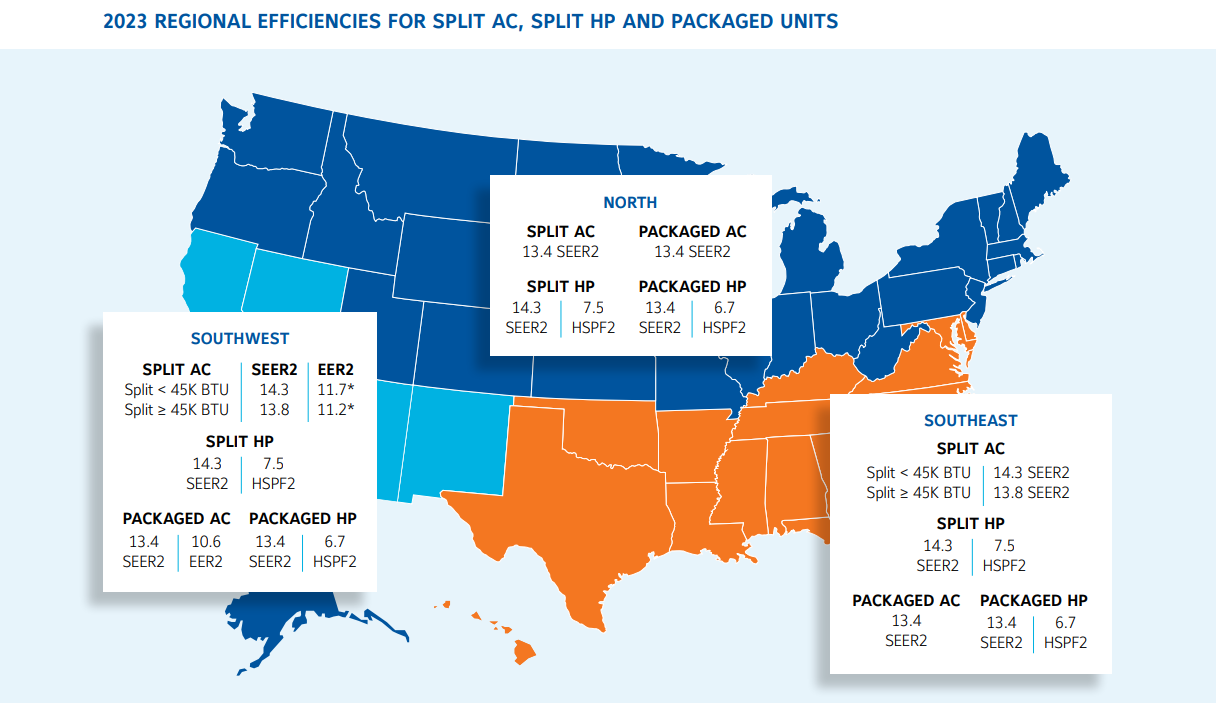Vice president of codes, standards and regulatory affairs Johnson Controls Inc.
It’s 2023. Do you know where your SEER2 products are?
That’s a question HVAC contractors need to ask themselves, as the new year brings new minimum energy-efficiency standards for single-phase residential air conditioners and heat pumps, as well as new methods of measuring efficiencies and new terms to describe those measurements.
The 2023 requirements come from the U.S. Department of Energy (DOE), which reviews efficiency standards for HVAC products every six years.
Instead of EER, SEER, and HSPF (Energy Efficiency Ratio, Seasonal Energy Efficiency Ratio, and Heating Seasonal Performance Factor), the new terms are EER2, SEER2, and HSPF2. The new metrics were necessitated because of new DOE testing procedures that included running the equipment at higher external airflow pressures than in the past in order to better simulate real-world conditions. The new names distinguish equipment that’s been tested under the new procedures from equipment that’s been tested under the old ones.
“The DOE test procedure has been updated to be more representative of installations in today’s homes, and will be used to determine product ratings,” said Jeff Goss, director of product management at Rheem. The new procedures and metrics apply to single-phase air conditioners and heat pumps with outputs of less than 65,000 Btuh, Goss said.
The 2023 DOE energy efficiency minimums vary according to product type and region of the country in which the products are being installed, but the bottom line as far as obtaining new equipment is this: Single-phase a/c units and heat pumps manufactured on after January 1 must be tested under the new procedures, have EnergyGuide labels that use the new terms, and meet or exceed the 2023 minimums.
Then it gets tricky.
“For residential products, the most important step for contractors is understanding which region they’re located in, the types of products they install ... and how the requirements for those products differ for their region,” said Chris Forth, vice president of codes, standards and environmental affairs at Johnson Controls Inc.
In Northern states (see map), the new minimum rating for both packaged and split a/c units is SEER2 13.4.

Click map to enlarge
MAPPING STANDARDS: This map shows the 2023 Department of Energy (DOE) energy-efficiency minimums for split and packaged a/c units in different regions of the U.S. (Courtesy of Johnson Controls)
In the Southeast and Southwest, the minimum for split a/c units under 45,000 Btuh is SEER2 14.3, and the minimum for split a/c units of 45,000 Btuh or more is 13.8. In the Southwest, split a/c units must also meet EER2 minimums: EER2 11.7 for those under 45,000 Btuh and EER2 11.2 for those 45,000 Btuh and over. For split a/c units in both output categories that are rated SEER2 15.2 or above, the EER2 minimum drops to 9.8 in the Southwest.
Packaged a/c units in the Southeast and Southwest must meet a minimum SEER2 of 13.4, and in the Southwest they also require a minimum EER2 rating of 10.6.
The 2023 efficiency minimums for heat pumps apply nationwide. For packaged heat pumps, the minimums are SEER2 13.4 and HSPF2 6.7. For split heat pumps, the minimums are SEER2 14.3 and HSPF2 7.5.
In the North, a/c products that were manufactured through 2022, and meet the energy efficiency requirements in place at the time they were made, can be installed in 2023.
But in the Southeast and Southwest, a/c units installed after December 31, 2022, must meet or exceed the new efficiency standards, as expressed by the new metrics, or meet or exceed the roughly equivalent standards under the older system of measurement (see chart). In the Southwest, a/c units must also meet the applicable EER2 (or equivalent EER) minimums. In the “equivalency” scenario, the product must also no longer be in production and must have been previously offered for sale in the same region, said Laura Petrillo-Groh, senior director of regulatory affairs at the Air Conditioning Heating and Refrigeration Institute (AHRI). A product that’s no longer in production is supposed to be marked as such in the AHRI certified products directory.
| All | North | South | Southwest | ||
| Type | HSPF2 (HSPF) |
SEER2 (SEER) |
SEER2 (SEER) |
SEER2 (SEER) |
EER2 (EER) |
| 13.4 (14) | 14.3 (15) | 14.3 (15) | 11.7 (12.2)/ 9.8* (10.2) |
||
|
NEW
|
13.4 (14) | 13.8 (14.5) | 13.8 (14.5) | 11.2 (11.7)/ 9.8* (10.2) |
|
| Heat Pump | 7.5 (8.8) | 14.3 (15) | |||
| Packaged Units | 6.7 (8.0) | 13.4 (14) | 10.6 (11) | ||
*9.8 EER2 limit for equipment ≥ 15.2 SEER2
TRANSLATION TABLE: This chart shows the approximate equivalencies between the new SEER2, EER2, and HSPF2 energy-efficiency metrics and the older ones, SEER, EER, and HSPF. Manufacturers came up with their own conversion methods; there are no conversion formulas that apply to all product brands, as the new test procedures affect different technologies differently. (Courtesy of Emerson)
However, a/c units that can’t legally be installed in the Southeast or Southwest after 2022 can be shipped to states in the North.
While there is no official DOE “crosswalk” between the older SEER, HSPF, and EER metrics and the new SEER2, HSPF2 and EER2 metrics, each manufacturer, said Forth, has come up with conversion methods that apply to its products, and must be able to inform contractors “which of their existing SEER, EER and HSPF a/c products for installation in the Southeast or Southwest would meet the new SEER2, EER2, and HSPF2 minimums.”
Products that have been tested and rated according to the new DOE test procedures, and meet the 2023 minimums, have been on the market since early 2022, which was allowed under the DOE’s early compliance guidance, Forth said.







